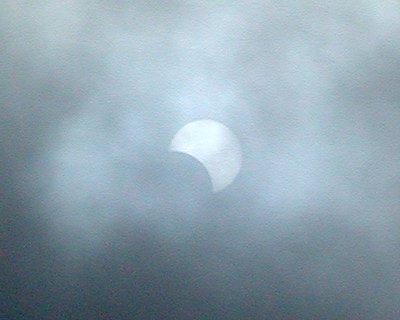« March 27, 2006 |
Main
| March 30, 2006 »
Wednesday, March 29, 2006
Solar Eclipse Captured through Clouds

Unlike the total solar eclipses of
1999 and
2001, the Fourmilab expedition to view the
eclipse of 2006-03-29 involved travel only to the adjacent parking lot. Having not been able to work a trip to the band of totality into the schedule, I settled for observing the partial eclipse visible from here. Even that didn't seem promising, as the odds on clear skies in late March are quite poor and the weather forecast was for clouds and intermittent rain the whole week with the eclipse in the middle.
Still, hope springs eternal, so the night before I set up the Olympus C3040Z camera on an astronomical tripod with a full aperture solar filter at hand just in case the clouds should part. Between first contact and maximum eclipse, there were thick low scudding clouds and off and on drizzle, but shortly after maximum eclipse (about 10:36 UTC, 12:36 local summer time) the clouds thinned and the partially eclipsed Sun occasionally peeked through. I set up the camera and shot pictures indiscriminately for about the next ten minutes to see what I'd get. All the pictures (except for a few experiments which didn't turn out) were taken with the lens zoomed to its maximum focal length of 21.3 mm with an Olympus 1.45× teleconverter attached (equivalent to a 150 mm lens on a 35 mm camera). Aperture and shutter speed were automatic, but in fact all pictures were taken at the minimum exposure of f/10 at 1/800 second; a neutral density filter would have saved several shots which ended up overexposed, but I don't have one which fits this camera. There is a substantial time parallax between the instant you press the shutter release and when the picture is actually taken with this camera, so I didn't even attempt to choose optimum moments—whenever the disc of the Sun was visible through the clouds, I just fired away as fast as I could.
The picture above, one of the first I took, is the best of a rather sorry lot. It is, however, perfectly representative of how the eclipse looked to the unaided eye; the cloud deck served as a solar filter and obscured any detail on the solar disc, of which there was
barely any to see here near the bottom of the
sunspot cycle. This photo was taken at 10:45 UTC, about ten minutes after maximum eclipse. At maximum, 43.5% of the Sun's diameter was covered by the Moon at this location, and in this picture about 40% remains occulted. Less than a third of the area of the Sun's disc was obscured by this eclipse, and there were no perceptible changes in the intensity or quality of the light; the clouds completely masked the already small decrease in insolation. I'd said that if I got clear skies for the
transit of Venus in 2004, I wouldn't gripe about the weather for at least ten years afterward, so I'm not complaining! I'm glad the clouds vouchsafed me a view of the spectacle in the sky and a chance to capture it in a photo.
Posted at
16:16


